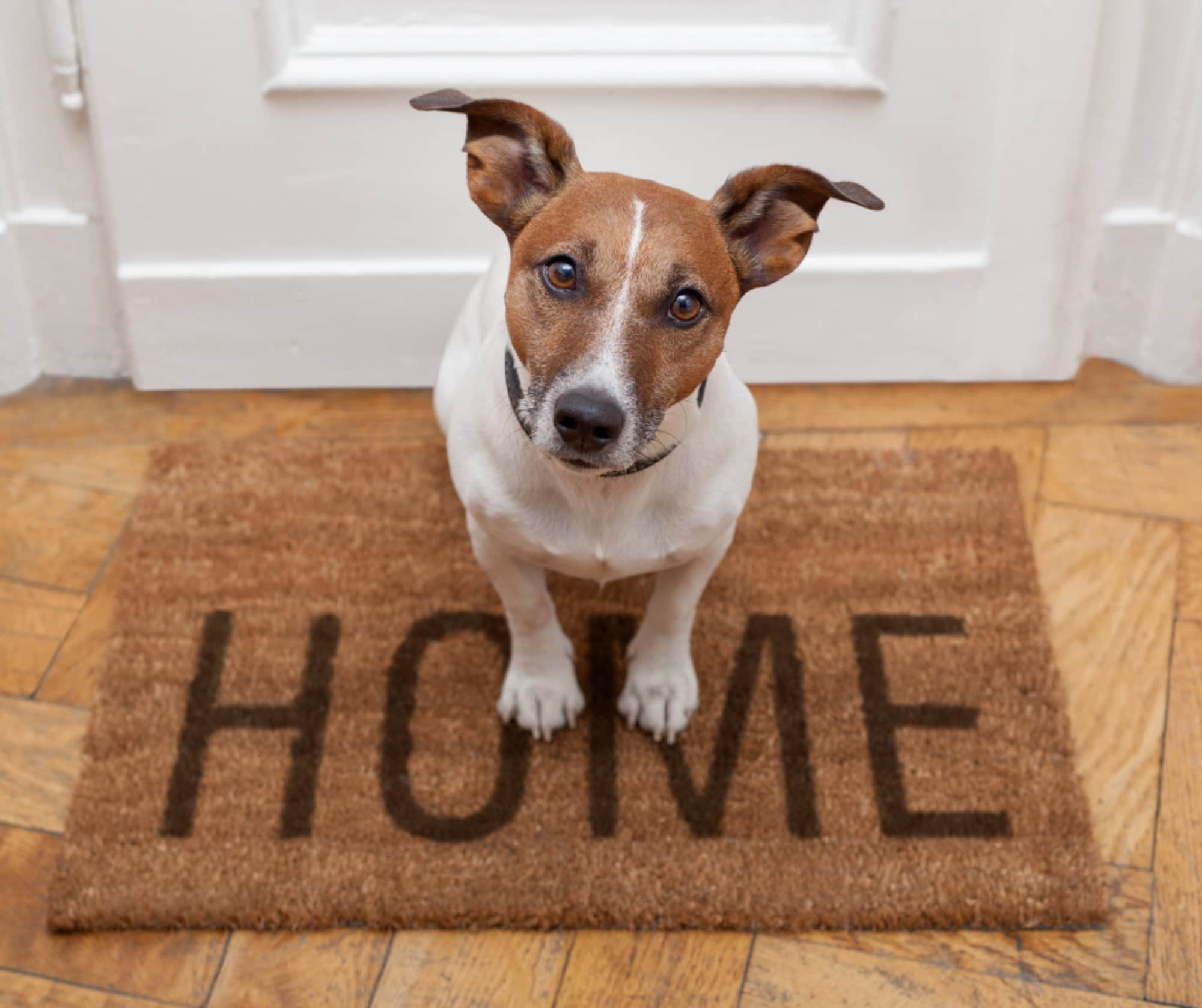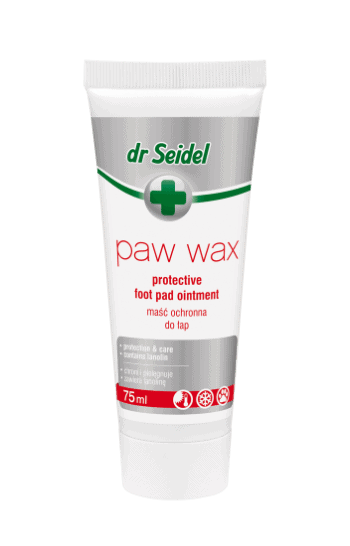Dog layette
Dog layette
Adopting a puppy or dog is a big event and it is important to prepare accordingly. Often carers are euphoric during their first purchases, but also indecisive – what will our dog really need? If you are unsure of the answer as to what your new canine companion needs, join us in preparing a layette for your dog so that he feels secure from the very first days!

Table of contents
- Dog resting place
1.1 Dog bed
1.2 Fabric playpen/kennel cage
1.3 Where in the house to put the dog bed? - Dog accessories
2.1 The right bowl for dog
2.2 Leash, collar, harness for dog
2.3 Toys for dog - Daily dog hygiene and grooming
3.1 How to choose the right shampoo?
3.2 How to look after dog’s paws?
3.3 How to look after dogs’ ear and eye hygiene?
3.4 How to protect dog from ticks? - Adapting a dog in a new home
4.1 Introducing a daily routine for dog
4.2 Preparations to support dog’s adaptation to a new location
Dog resting place
Dog bed
Your dog’s bedding must be made of sturdy materials – your puppy can test his teeth on it. The size of the bed should allow the dog to stretch out on it – over time, as your pet grows, you may need to replace the bed with a larger one. It’s a good idea to buy a dry bed (which absorbs urine and water, keeping the bed dry while not soaking into the ground) or one with a removable cover for easy washing.
Fabric playpen/kennel cage
A cage or pen allows you to create a relaxation and resting area for your pet. The playpen needs to be of such a size that a dog bed can go inside and the dog can stretch out inside. A portable playpen also allows you to take a piece of home with you when you travel, for example on holiday – this provides your dog with a sense of security.
Where in the house to put the dog bed?
The lair should be situated in a quiet and somewhat isolated location, while still providing the pet with a ‘good vantage point’ of its surroundings and carer. The dog should feel calm and comfortable there. The dog’s resting place has to be a kind of asylum, so that it feels safe there, which excludes placing the bed in a corridor or other places where one often passes. The bed must not be placed next to a direct heat source such as a radiator or in draughts.
Dog accessories
The right bowl for dog
The dog must have two bowls – for food and water or three – for dry food, wet food and water. The size of the bowl is chosen according to the size of the dog and the nutritional needs of the breed. Bowls should be difficult to tip over and move – metal bowls with a non-slip seal or ceramic bowls can work well here. It is also a good idea to get a protective pad under the bowls – this prevents the floor from getting dirty when eating or drinking.
Leash, collar, harness for dog
The collar is the most popular dog walking accessory, but increasingly carers are turning to harnesses. So what should you choose – a collar or a harness?
A collar gives you a lot of control over your dog, and it is usually very quick to put on. However, we need to bear in mind that the dog may pull the carer on the lead while walking, which can lead to injuries to the dog’s back or respiratory problems. A harness, due to its much larger support surface, reduces the risk of spinal injury. However, we must remember that the harness should be properly selected for the dog – with regard to size, breed predisposition and physical activity.
When it comes to the leash, the situation is similar – it all depends on the predisposition of the dog, but also on whether it is a training, sports or walking leash. A city leash should be 170-220 cm, while a walking leash should be 220-300 cm. As for the width of the leash, one rule applies – the bigger the dog, the wider the leash.
Before the first walk, it is a good idea to arm yourself with other useful accessories, such as excrement bags or clothing for dogs without undercoats.
Toys for dog
It is worth spending time every day playing with a new member of the household – it builds a bond between the dog and the owner. Through play, the dog also learns appropriate behaviors and new skills faster. It is important that the dog does not receive too many stimuli at once – 3-4 toys, replaced with different ones from time to time, are enough. It is also good to include scent mats or tasty balls in which you can hide treats for the dog. This gives you the opportunity to train your dog’s sense of smell, supports the learning process and teaches self-confidence. Playing with the olfactory mat is easy, intuitive and pleasant. Just place the item on the floor and hide health-promoting treats in the material, e.g. dr Seidel snacks for healthy puppies and encourage the dog to play.
Daily dog hygiene and grooming
How to choose the right shampoo?
• Products specifically designed for bathing should be used. Human’ cosmetics are not recommended as they are not adapted to the needs of the animal’s skin and coat.
• It is important to pay attention to the safety and quality of the products in order to ensure that you do not harm your pet.
• Avoid shampoos that contain dyes, which can cause irritation and allergies.
• Pay attention to the fragrance of shampoos. Research shows that unscented products are best tolerated by animals. Aromas that are attractive to humans may be unpleasant to the dog’s nose.
• Puppies should be bathed in gentle shampoos specifically designed for puppies, which contain milder detergents and more lubricating substances than preparations designed for adult dogs.
We particularly recommend dr Seidel’s series of shampoos. These are specialised care products for use in standard healthy skin care as well as in the treatment of skin problems.
• They have a suitable pH, adapted to the needs of the skin of pets.
• They clean thoroughly and care for the skin at the same time, as they contain lubricating substances
ingredients that help restore the skin’s protective barrier
• They are free of colourings and fragrance additives.
• They have enjoyed a good reputation among pet carers and industry professionals for years – they are recommended by veterinarians and pet shop staff.
How to look after dog’s paws?
Dogs should have their claws trimmed regularly. Our four-legged housebrothers are unable to trim their claws themselves, and without regular trimming, they may have difficulty walking or the claws may grow in. It is also important to pay attention to the fur on the paws – too long can cause the dog to slip on the floor.
Your dog’s paws should be cared for all year round. After walks, especially in the rain or winter, they should be washed thoroughly. In addition, it is worth stocking up on paw care and protection products, such as dr Seidel’s Paw Wax protective foot pad ointment. Paw Wax moisturises and lubricates paw pads leaving a protective layer, which protects your dog’s paws from injury, cracking and drying out caused by walking on hard surfaces, frost or heat.
How to look after dogs’ ear and eye hygiene?
The frequency of dog ear grooming depends on lifestyle and breed. Dogs with long ears or dogs that like to swim require special attention even every few days. Dogs’ ears should be cleaned using products designed for this purpose, such as dr Seidel’s Ear cleaner for dogs and cats. The lotion effectively removes dirt and secretions, thus preventing the growth of bacteria in the auricle and ear canal. It softens the epidermis and stimulates its regeneration. The menthol contained in the product reduces itching and prevents the animal from scratching the ears.
Remember! Never clean your dog’s ears with a stick – this can ‘push’ ear wax inside the ear or damage the dog’s ear when it moves! Wadding is also unsuitable – a piece of it can get stuck in the ear. It is best to use a soft applicator (Dr Seidel liquid has such an applicator) or a cotton swab with the product applied.
The eye area is an extremely delicate place. A dog’s eyes should even be washed daily with a dedicated fluid, such as dr Seidel’s Eye cleaner for dogs and cats. Gently and effectively removes impurities and secretions in the eye area. Contains moisturising and lubricating ingredients to prevent dryness of the skin. Thanks to allantoin and infusions of holly and green tea, it soothes irritation caused by eye secretions.
In addition to washing the eye area, in the case of long-haired breeds, the hair on the animal’s muzzle should also be trimmed regularly so that the hair does not irritate the eyes.
How to protect dog from ticks?
The tick is a parasite that prefers damp forests, but is also increasingly common in urban parks and gardens. In our climate, it is active all year round, which increases the risk of transmitting dangerous diseases. It is therefore important to provide year-round protection for our pets, especially against dangerous diseases such as babesiosis and Lyme disease. Sabunol PLUS is a proven collar combining anti-tick and anti-flea functions. They guarantee an effective elimination of ticks and fleas for a period of 5 months thanks to their content of 3 active substances: permethrin, imidacloprid and geraniol. When the collar is worn, these substances are released and spread on the skin and coat of the dog, acting on ticks and fleas in a contacting manner. The aim of the action of these substances is to disrupt the nervous system of ticks and fleas leading to the death of the parasites.
Adapting a dog in a new home
Introducing a daily routine for dog
A daily routine is very important for a dog. It helps him to adapt in a new place, makes the dog feel secure, safe and builds a bond with his guardian.
The daily schedule should include consistent feeding times, regular walks and grooming, including cleaning eyes, ears, teeth and combing. Playtime and training are also essential as the dog learns through play, develops the right behaviours and builds a bond with the carer, which contributes to the dog’s happiness and, in turn, the carer’s.
Preparations to support dog’s adaptation to a new location
However, a dog can sometimes struggle to adapt to new surroundings, especially if it has been adopted from a shelter, for example. In addition to a routine and playtime combined with training, it may be worthwhile to use behavioural aids, such as dr Seidel’s adaptation series, which includes Adaptation collar, Adaptation spray, Electric adaptation vaporizer.These preparations contain a composition of natural substances that affect animal behaviour in a similar way to canine pheromones. They provide the dog with a sense of security. They are suitable for dogs of all ages.
17 April 2024





